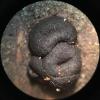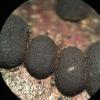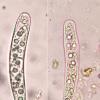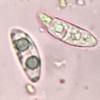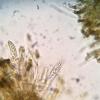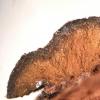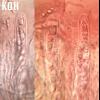
05-09-2017 09:31
Pascal RIBOLLETBonjour Forum,Trouvé sur écorce de feuillu, il �

01-09-2017 00:58
Valencia Lopez Francisco JavierHola a todos.Presento estos ascos recolectados est

07-09-2017 00:57
Joanne TaylorEvening all,An interesting stromatic cupulate coel

05-09-2017 11:55
 Viktorie Halasu
Viktorie Halasu
Hello forum,would anyone have this article please?

06-09-2017 17:48
Dear forum! I am looking for data on cultural cha

06-09-2017 05:36
Ethan CrensonIn New York City, Inwood Hill Park. On a branch of

05-09-2017 12:27
Watt JohnWhilst on recording foray with Northwest Fungus Gr
Black pulvinate asco on Prunus
Ethan Crenson,
26-08-2017 15:56
Hans-Otto Baral,
26-08-2017 16:08

Re : Black pulvinate asco on Prunus
Hi Ethan
Remarkable fungus! I am not sure if the asci stand in a hymenium at the surface of these ascomata or if they are in cavities, i.e., perithecia in a stroma. Do you have survey photos of a section that perhaps show such cavities?
The ionomidotic KOh reaction reminds of a Codieritidaceae
Zotto
Remarkable fungus! I am not sure if the asci stand in a hymenium at the surface of these ascomata or if they are in cavities, i.e., perithecia in a stroma. Do you have survey photos of a section that perhaps show such cavities?
The ionomidotic KOh reaction reminds of a Codieritidaceae
Zotto
Ethan Crenson,
26-08-2017 22:10
Re : Black pulvinate asco on Prunus
Zotto,
In the fourth photo I tried to show a cross section of two ascomata. As you can see there is a distinct dark layer at the surface and light brown tissue in the interior. However, I don't detect perethecia in the black layer. I am including a closer version of one of the section photos here.
I can't find Codieritidaceae in Google. If there's a typo, I'm afraid I can't figure it out.
Ethan
In the fourth photo I tried to show a cross section of two ascomata. As you can see there is a distinct dark layer at the surface and light brown tissue in the interior. However, I don't detect perethecia in the black layer. I am including a closer version of one of the section photos here.
I can't find Codieritidaceae in Google. If there's a typo, I'm afraid I can't figure it out.
Ethan
Hans-Otto Baral,
26-08-2017 22:18

Re : Black pulvinate asco on Prunus
Sorry, it is Cordieritidaceae. It is a vast group of encoelioid discomycetes.
I would prefer doing a thin section for transmitted light, and also to show the paraphyses.
It may be important too to look whether the ascus tip gets thick-walled in the dead state (after shortly heating the slide or adding MLZ or KOH).
I would prefer doing a thin section for transmitted light, and also to show the paraphyses.
It may be important too to look whether the ascus tip gets thick-walled in the dead state (after shortly heating the slide or adding MLZ or KOH).
Ethan Crenson,
26-08-2017 22:27
Hans-Otto Baral,
27-08-2017 07:20

Re : Black pulvinate asco on Prunus
Yes, it looks like a hymenium covering the whole exterior. I see dark olive dots on the hymenial surface which probably represent exudate on the paraphysis tips, could you supply a photo with oil immersion showing thse tips? I assume in KOH this exudate gets dissolved as well?
What also shows the ionomidotic reaction is the genus Dermea. This should contain crystals in the medulla and angular cells in the ectal excipulum.
What also shows the ionomidotic reaction is the genus Dermea. This should contain crystals in the medulla and angular cells in the ectal excipulum.
Ethan Crenson,
29-08-2017 06:51
Re : Black pulvinate asco on Prunus
Otto,
Yes, the exudate on the paraphysis tips dissolves in KOH. In the photos provided here you can see the paraphyses, both covered in the exudate and naked. I've also tried to find the features of asci in the dead state and the exipulum that you mentioned, but I'm not sure if I succeeded.
Thank you for your help,
Ethan
Yes, the exudate on the paraphysis tips dissolves in KOH. In the photos provided here you can see the paraphyses, both covered in the exudate and naked. I've also tried to find the features of asci in the dead state and the exipulum that you mentioned, but I'm not sure if I succeeded.
Thank you for your help,
Ethan
Hans-Otto Baral,
29-08-2017 07:34

Re : Black pulvinate asco on Prunus
Yes, this looks good enough to make up one's mind. The apical thickening of the asci is clearly visible, also I think I see many crystals in the excipulum. The latter would clearly exclude a Cordieritidaceae and support that this is a Dermea.
When I go with Groves' (1946) key in Mycologia 38: 364, then I arrive at the common Dermea cerasi. Ascus and spore size fits well (dead asci in KOH are certainly smaller than the living ones you have measured). Only the anamorph is missing, but anyway I am sure.
Zotto
When I go with Groves' (1946) key in Mycologia 38: 364, then I arrive at the common Dermea cerasi. Ascus and spore size fits well (dead asci in KOH are certainly smaller than the living ones you have measured). Only the anamorph is missing, but anyway I am sure.
Zotto

